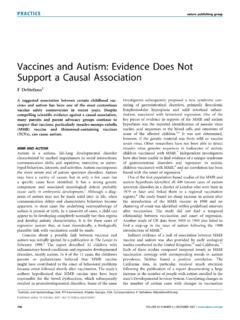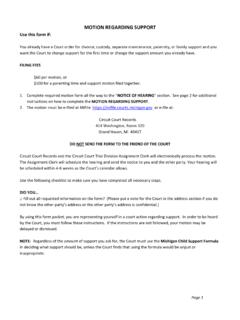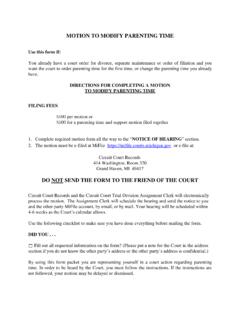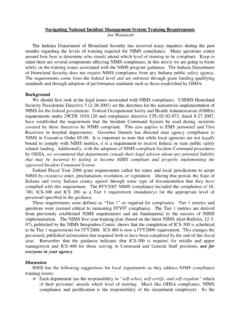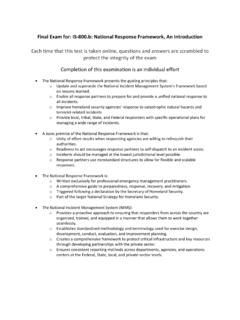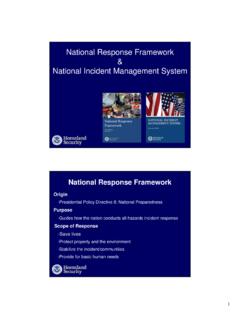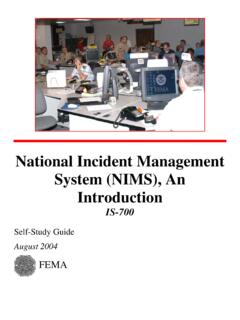Transcription of Final Exam for: IS-700.a National Incident …
1 Final Exam for: National Incident management system (NIMS), I-700 Privacy Act Statement (Public Law 93 579) Please note that you will be required to enter your Social Security number at the completion of this exam. This website and the testing system meet federal guidelines for protecting Personally Identifiable Information. However, if you do not wish to submit your Social Security number, you will need to request an alternative ID number from the Independent Study program. For directions on how to request an alternative ID number, please see our Frequently Asked Questions: Instruction Please print and keep a copy of your exam answers prior to their submission. Complete All answers and Enrollment Form then submit. To mark an answer, click on the empty circle after your answer choice so a black dot appears. Clicking on a different circle will change your answer. NOTE: PLEASE BE ADVISED THAT WHEN YOU GO TO TAKE THE Final EXAM ONLINE THAT THE EXAM MAY BE IN A DIFFERENT ORDER THEN THE QUESTIONS PROVIDED BELOW.
2 TO ENSURE THAT YOU PASS THE COURSE, PLEASE READ EACH QUESTION ONLINE AND BEWARE OF THE ORDER OF THE ANSWERS. THIS WILL ENSURE THAT YOU ARE ANSWERING THE QUESTIONS CORRECTLY. THE FEMA WEBSITE DOES OCCASIONALLY MIX UP THE QUESTIONS AND THE ORDER OF THE ANSWERS. Question 1 of 20 : Which of the following statements is FALSE? a. NIMS is based on best practices collected from all levels of responders. b. NIMS integrates best practices into a comprehensive, standardized framework. c. NIMS is applicable across the full spectrum of potential incidents, regardless of cause, size, location, or complexity. d. NIMS specifies how resources will be allocated among jurisdictions. Question 2 of 20 : Select the statement below that best describes one benefit of NIMS. a. Establishment of standardized organizational structures that improve integration among jurisdictions and disciplines. b. Funding for additional staff and other resources to address operations that are not NIMS compliant.
3 C. Creation of a comprehensive tactical plan for operational Incident management that can be used for every Incident . d. Development of comprehensive strategies for addressing the management of international events. Question 3 of 20 : Homeland Security Presidential Directive 5 (HSPD-5) requires all Federal departments and agencies to: a. Establish a panel that will evaluate activities at the State, tribal, and local levels to ensure compliance with NIMS. b. Make adoption of NIMS by State, tribal, and local organizations a condition for Federal preparedness assistance (through grants, contracts, and other activities). c. Create NIMS strike teams that can mange Incident operations if a local government fails to comply with NIMS. d. Implement NIMS as the doctrine for how best to organize and manage all routine, day-to-day department/agency operations. Question 4 of 20 : The National Response Framework (NRF) presents the guiding principles that: a.
4 Are singly focused on improving Federal homeland security agencies response to catastrophic natural hazards and terrorist-related incidents. b. Supersede the National Incident management system s framework when Federal agency and departments are assisting in a response. c. Provide the structure and mechanisms to ensure effective Federal support of State, tribal, and local related activities. d. Mandate specific operational plans for local responders to use when managing a wide range of incidents. Question 5 of 20 : A basic premise of the NIMS and National Response Framework (NRF) is that: a. Incidents should be managed at the lowest jurisdictional level possible. b. Unity of effort and command results when responding jurisdictions and agencies are willing to relinquish their authorities. c. Effective response relies on the readiness of response partners to self-dispatch to an Incident scene. d.
5 Preparedness is inherently a government responsibility and does not require participation from nongovernmental organizations. Question 6 of 20 : To better serve their constituents, elected and appointed officials should do the following, EXCEPT FOR: a. Help to establish relationships (including mutual aid agreements and assistance agreements) with other jurisdictions and, as appropriate, with nongovernmental organizations and the private sector. b. Provide guidance to their jurisdictions, departments, and/or agencies, with clearly stated policies for NIMS implementation. c. Understand laws and regulations in their jurisdictions that pertain to emergency management and Incident response. d. Assume the role of Incident commander for all incidents and direct the on-scene technical operations from the Emergency Operations Center. Question 7 of 20 : Mutual aid agreements and assistance agreements provide: a.
6 Strategies for restoring critical infrastructure that affects multiple sectors and jurisdictions across specified geographical areas. b. Mechanisms to quickly obtain emergency assistance in the form of personnel, equipment, materials, and other associated services. c. Steps for ensuring the continuity of government at the local, tribal, and State levels following a catastrophic Incident . d. Lists of specialized codes for facilitating communication among responders representing different departments, agencies, and jurisdictions. Question 8 of 20 : 8. Exercises should: Include multidisciplinary, multijurisdictional incidents. Include participation of private-sector and nongovernmental organizations. Cover aspects of preparedness plans, including activating mutual aid and assistance agreements. _____ a. Contain a mechanism for incorporating corrective actions. b. Have consequences for inadequate performance.
7 C. Be repeated until performance is at an acceptable level. d. Be based on the most catastrophic scenario that could affect the community. Question 9 of 20 : ICS encourages jurisdictions to use common terminology. Common terminology: a. Is unique terminology that responders use when managing incidents. b. Encourages the use of radio codes to communicate efficiently at Incident site. c. Applies exclusively to the naming of facilities used by the Command Staff. d. Uses plain English to allow personnel from different agencies to work together. Question 10 of 20 : Interoperability: a. Primarily involves creating automated systems that allow for the sharing of sensitive Incident information. b. Is the ability of emergency management /response personnel to interact and work well together. c. Requires nongovernmental and private-sector organizations to purchase standardized communication equipment.
8 D. Involves oversight by the Federal Communications Commission for assigning emergency frequencies. Question 11 of 20 : Incident managers begin planning for the demobilization process: a. When Incident activities shift from response to recovery. b. Right before the first resources are ready to be released. c. As soon as possible to facilitate accountability of the resources. d. After being requested by the Emergency Operations Center. Question 12 of 20 : The credentialing process involves an objective evaluation and documentation of an individual's: Current certification, license, or degree, Training and experience, and _____. a. Security clearance level. b. Supervisory expertise. c. Competence or proficiency. d. Compensation amount. Question 13 of 20 : The act of directing, ordering, or controlling by virtue of explicit statutory, regulatory, or delegated authority at the field level is referred to as: a.
9 Coordination b. Command c. Direction d. Leadership Question 14 of 20 : Who is the individual responsible for all Incident activities, including the development of strategies and tactics and the ordering and release of resources? a. Incident Commander b. Operations Section Chief c. Emergency Operations Center Manager d. Agency Executive or Senior Official Question 15 of 20 : Unified Command: a. Assigns a single Incident Commander to assume unity of command and make decisions for all jurisdictions. b. Enables all agencies with responsibility to manage an Incident together by establishing a common set of Incident objectives and strategies. c. Requires that employees report to several different Incident Commanders, each representing each jurisdiction. d. Obligates all responsible agencies to pool their resources without consideration to the terms of mutual aid and assistance agreements. Question 16 of 20 : Which organization has line authority to oversee the management of multiple incidents being handled by separate Incident Command organizations?
10 A. Multiagency Command b. United Command c. Area Command d. Joint Command Question 17 of 20 : In an Incident Command system organization, the term General Staff refers to: a. Generalists who are assigned to support Section Chiefs with functions such as administrative matters and documentation of Incident events. b. A person assigned by a cooperating agency or nongovernmental/private organization who has been delegated authority to make decisions affecting that agency s or organization s participation in Incident management activities. c. Any combination of personnel resources assembled to support a specific mission or operational need with common communications and a designated leader. d. Incident management personnel organized according to function ( , Operations Section Chief, Planning Section Chief, Logistics Section Chief, and Finance/Administration Section Chief) and who report directly to the Incident Commander.







